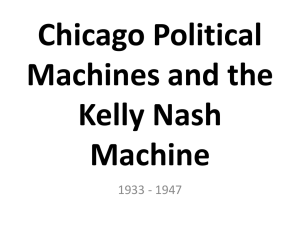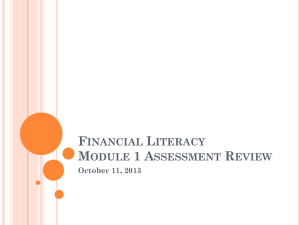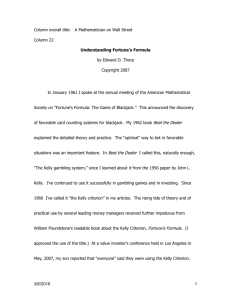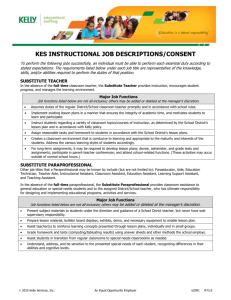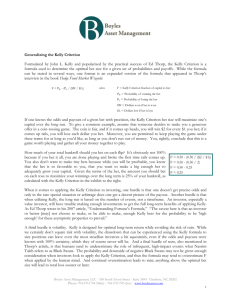Log Optimal Portfolio: Kelly Criterion
advertisement
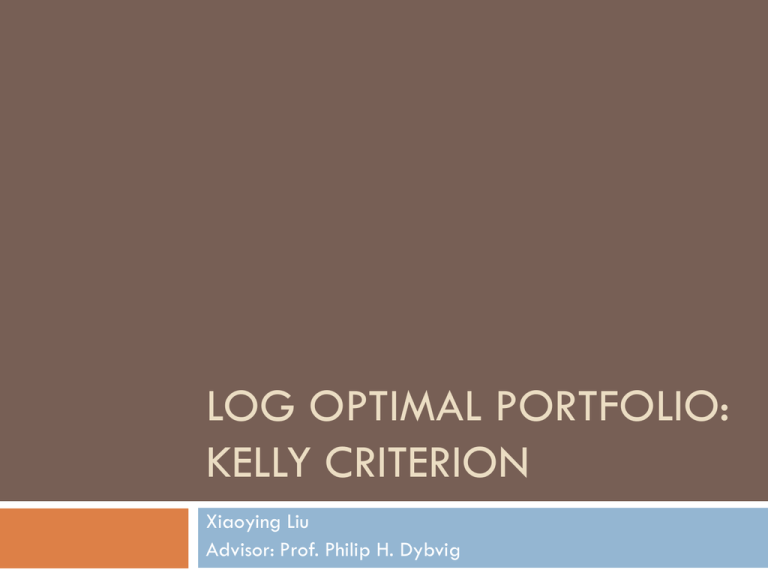
LOG OPTIMAL PORTFOLIO: KELLY CRITERION Xiaoying Liu Advisor: Prof. Philip H. Dybvig Content What is Kelly Criterion? Good and bad properties of Kelly Criterion Proof: Limitation of Kelly Criterion A Gamble Problem Given an initial stake 𝑊0 At the beginning, we will choose the fraction bet f, for each round afterwards In order to get the maximal stake at the end of the gamble, what f should we choose? Kelly Criterion Kelly (1956) defined “exponential rate of growth”, or “long run growth rate” as The link between Kelly rule and log utility Good Properties Maximizing E(logW) asymptotically maximizes the rate of asset growth. The absolute amount bet is monotone increasing in wealth. Never risks ruin Has an optimal myopic policy Bad Properties Kelly criterion can be very risky in the short term. Kelly criterion is limited to use when risk aversion is equal to one What if risk aversion is not equal to one The Optimization Problem Objective: 𝑊𝑡 1−𝑅 1−𝑅 U Wt = U Wt = 𝑙𝑜𝑔 (𝑊𝑡) The Optimization Problem - U Wt = 𝑊𝑡 1−𝑅 1−𝑅 Value function for the optimal strategy V(t, w) where Conjecture that with h(T) = 1 We get Therefore, The Optimization Problem -U(Wt) = log(Wt) Value function for the optimal strategy V(t, w) where Conjecture that with and We get g(t) = g(T) = 1 and Therefore, The Optimization Problem Assume we invest a fraction f in the stock 𝑊𝑡 = 𝑘𝑓 𝑡 𝑓 𝑊0 𝑒 𝑠𝑡 , by Ito’s lemma, we get 1 𝑘𝑓 = 𝑟 1 − 𝑓 − 𝑓(𝑓 − 1)𝜎 2 2 The Optimization Problem Given a random variable c, the certainty equivalent of c is the constant amount CE(c) that yields the same utility as c, i.e., u(CE(c)) = E[u(c)] Here, 𝑓 𝑊𝑡1−𝑅 (𝑊0 𝑒 𝑘𝑓𝑡 𝑆𝑡 )1−𝑅 E u Wt = 𝐸 = 𝐸[ ] 1−𝑅 1−𝑅 The Optimization Problem Since Wt is E u Wt 𝑊𝑡1−𝑅 log normal, is also log normal, we get 1−𝑅 1 1 1−𝑅 𝑙𝑜𝑔𝑤0+𝑘𝑓 𝑡+𝑓 𝜇− 𝜎2 𝑡 −log 1−𝑅 + (1−𝑅)2 𝜎2 𝑡 =𝑒 2 Then we get CE 𝑊𝑡 = And we already know 1 1 𝑘𝑓 𝑡+𝑓 𝜇−2𝜎2 𝑡+2(1−𝑅)𝜎2 𝑡 𝑊0 𝑒 1 2 𝑘𝑓 = 𝑟 1 − 𝑓 − 𝑓(𝑓 − 1)𝜎 2 and f = So CE 𝑊𝑡 = 𝑊0 𝑒 [𝑟+ 2 𝜇−𝑟 2 ]𝑡 2𝑅𝜎2 𝜇−𝑟 𝑅𝜎2 The Optimization Problem E[u(Wt)] = E(logWt) CE 𝑊𝑡 = 𝑊0 𝑒 CE 𝑊𝑡 = 𝑊0 𝑒 1 2 𝑘𝑓 𝑡+𝑓 𝜇− 𝜎2 𝑡 [𝑟+ 𝜇−𝑟 2 ]𝑡 2𝜎2 with f = 𝜇−𝑟 𝜎2 When risk aversion gets really high, to reach the same utility, initial wealth would be a big number R = 3, by using log optimal strategy, you need to invest $600 to get the same utility compared to $100 by using the optimal strategy R = 10, $1200 V.S. $100 Summary Kelly criterion is linked to the logarithmic utility, and thus implicitly assume that the relative risk averse is always equal to one. Investors having different relative risk averse are not optimized by Kelly.


